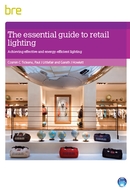The essential guide to retail lighting
BRE (Building Research Establishment) is an independent, research-based consultancy, testing and training organisation, operating in the built environment and associated industries.
On 3 September 2013, BRE published, The essential guide to retail lighting: Achieving effective and energy-efficient lighting (FB 56), written by Cosmin Ticleanu, Paul Littlefair and Gareth Howlett. It was funded by the BRE Trust.
Despite the fact that lighting products are becoming more energy efficient, overall, the amount of energy used for retail lighting has increased. This is, in part, because of longer opening hours and higher light levels, but it is compounded by inappropriate control strategies and improper choice of light sources, and it results in reduced profitability and has environmental impacts.
The retail sector consumes more lighting energy than any other commercial sector; accounting for 35% of the energy consumption for lighting in the entire service sector, and 43% of the electricity used in the retail sector.
Energy consumption can be improved by the use of modern lighting techniques and equipment, and more efficient light sources, whilst providing an enhanced level of illumination and improved visual appeal.
This 68 page guide reviews current practice in retail lighting and offers advice about energy savings. It provides practical guidance for retailers, architects and designers about refurbishing existing lighting systems and developing new lighting solutions.
Its contents are:
- Glossary.
- Introduction.
- Design principles.
- Review of current solutions in retail lighting.
- State of the art technologies in lighting.
- Guidelines for improved lighting design.
- Conclusions.
- References.
- Appendix: Checklist for refurbishment.
[edit] Find out more
[edit] Related articles on Designing Buildings Wiki
- 7 ways better lighting can improve your health.
- BRE articles on Designing Buildings Wiki.
- BRE Expert Collection 6 Daylight and shading.
- Building Research Establishment.
- Cheshire Oaks: Marks and Spencer
- Daylight benefits in healthcare buildings
- Daylight lighting systems.
- General lighting v task lighting.
- Health and wellbeing impacts of natural and artificial lighting.
- Lamp.
- Lighting.
- Lighting and energy efficiency.
- Lighting and health infographic.
- Lighting designer.
- Reducing the embodied impacts of shopfitting equipment.
- Site layout planning for daylight and sunlight
- The impact of lighting in retail design
- Use of lighting to improve health and wellbeing
Featured articles and news
Infrastructure that connect the physical and digital domains.
Harnessing robotics and AI in challenging environments
The key to nuclear decommissioning and fusion engineering.
BSRIA announces Lisa Ashworth as new CEO
Tasked with furthering BSRIA’s impressive growth ambitions.
Public buildings get half a million energy efficiency boost
£557 million to switch to cleaner heating and save on energy.
CIOB launches pre-election manifesto
Outlining potential future policies for the next government.
Grenfell Tower Inquiry announcement
Phase 2 hearings come to a close and the final report due in September.
Progress from Parts L, F and O: A whitepaper, one year on.
A replicated study to understand the opinion of practitioners.
ECA announces new president 2024
Electrical engineer and business leader Stuart Smith.
A distinct type of countryside that should be celebrated.
Should Part O be extended to existing buildings?
EAC brands heatwave adaptation a missed opportunity.
Definition of Statutory in workplace and facilities management
Established by IWFM, BESA, CIBSE and BSRIA.
Tackling the transition from traditional heating systems
59% lack the necessary information and confidence to switch.
The general election and the construction industry
As PM, Rishi Sunak announces July 4 date for an election.
Eco apprenticeships continue help grow green workforce
A year after being recognised at the King's coronation.
Permitted development rights for agricultural buildings
The changes coming into effect as of May 21, 2024.























